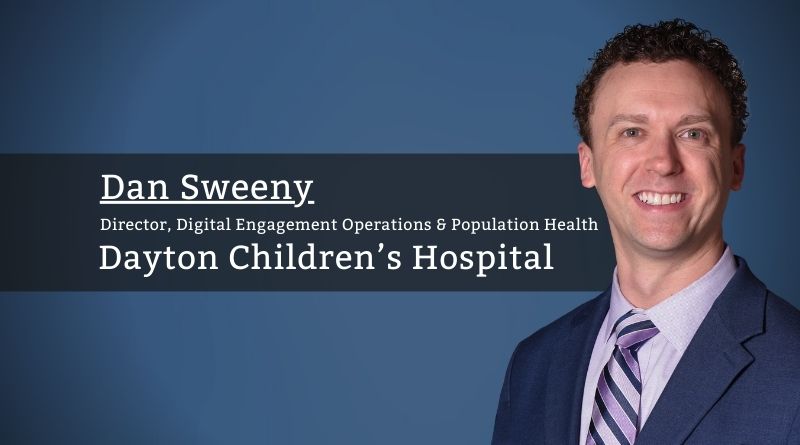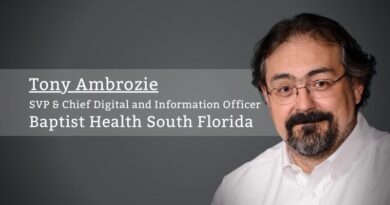Digital Transformation of the Pediatric Care Experience
By Dan Sweeny, Director, Digital Engagement Operations and Population Health, Dayton Children’s Hospital
While the rest of the world has been changing with the digital times for decades, the healthcare lag has finally caught up and we are now scrambling to meet the needs and demands of the consumer and workforce. In pediatrics, those expectations are being set by generations that have grown up in the digital age, fueling the sense of urgency.
Nearly fifteen years after the federal Meaningful Use program jumpstarted a robust adoption of Electronic Health Records (EHR), the usability- particularly for the consumer- has not capitalized on the potential that other industries have realized. Thinking about how interactions occur with almost any other business you realize there is often a choice to interact digitally or by “old-fashioned” approaches. In some cases, it’s entirely digital and if you are not willing to participate in that way, you could be excluded. In healthcare, specifically at Dayton Children’s Hospital, we are working towards giving people the choices so that we can meet them where they are and make the necessary changes faster than ever.
Critically and primarily important to the success of digital transformation is infrastructure. Due to disparities in the community, this can be the ultimate barrier leading to inequity amongst families and their ability to utilize all the digital tools we have to offer. Like traveling across the country before the Interstate Highway System or consuming electricity without public or private utility companies, it’s impossible to fully achieve the desired state without a solid infrastructure, powering the digital transformation being strived for. Despite all the negatives that came out of the COVID-19 pandemic, one bright light was the speed at which the digital divide became a priority. For our pediatric patients, it was the fact that many could not attend their classes virtually from home. While there is much work to be done to ensure everyone in our communities has the ability to stay connected, the government and private organizations have helped to decrease the gap by developing robust programs aimed at delivering high-speed internet to rural areas and to those families that couldn’t otherwise afford it. We now have government-subsidized housing with neighborhood Wi-Fi, creating opportunities for many of the families we serve to seek care in ways they previously could not.
Creating something we think people want is a great way to waste time and resources- both of which are at a premium.
We have been fortunate at Dayton Children’s to have the support of our leadership to make the expansion of how we interact with our patients and families a priority. Prior to making any changes, there are questions that must be answered and often by people not in our employment- the families themselves. This was a lesson learned the hard way initially, implementing a few solutions that earned minimal adoption by the actual consumer. With great support from patient and family advocates, we can now discuss how patient families want to interact with the hospital, or we can offer potential solutions to gauge interest and buy-in. Creating something we think people want is a great way to waste time and resources- both of which are at a premium. Aside from the families, our providers and clinical teams are another key piece that is needed to offer insight into what is actually needed and how to make it work. Going through such a transformational change requires the collaboration of all parties.
My personal approach to this work is focused on how these digital transformations will improve experience, efficiency, and convenience for all consumers- internal and external. As a parent in the 21st century, my life is always busy, sometimes a bit chaotic. Right or wrong, millennials will prioritize convenience and saving time, so why do we continue to make people call to schedule an appointment? For us, it took engaging with the providers to understand their concerns with what they saw as “losing control” of their schedules. There are consumers that will only seek out the businesses that offer those online interactions, wanting to avoid speaking to a person at all. Even if our only motive is to capture that subset of digital-only individuals and provide them with the opportunity to receive our high-quality care and excellent patient experience, do we even need another reason? We were among the first pediatric hospitals to offer online scheduling to new, subspecialty patients. It was a challenge, but the subsequent numbers told us that this was how many families wanted to begin their care journey with us. With a scheduled appointment in hand, reminders via text have been the norm for some time now, but we wanted to take it above and beyond that use case. Implementing two-way texting with a patient’s clinic team has been met with positive feedback from both the families and the internal staff. The efficiencies gained operationally were substantial due to staff not spending excess time tracking people down via phone calls and parents not spending time on hold waiting for simple answers that can be communicated digitally via text.
We make these efforts and change the way we work because it is what people expect. Consumers don’t only compare their interactions with us to other healthcare providers. They expect the same experience that they receive from their bank, airline, and even their grocery store. The commonality comes back to an easy, efficient, and convenient way to interact through digital means.



